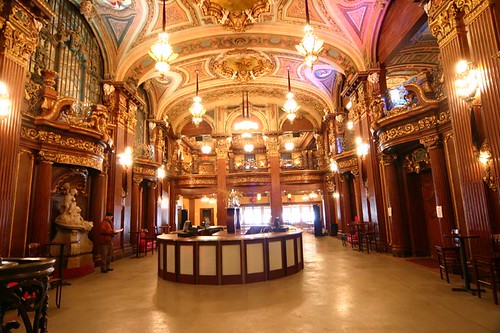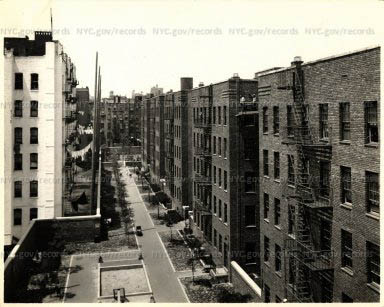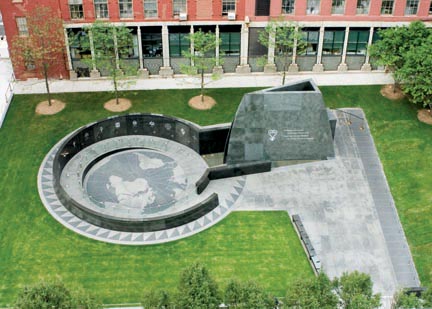This week is an anniversary worth honoring, yet one that is going by relatively quietly. Fifty-five years ago, on April 19, 1965, New York City Mayor Robert F. Wagner signed the city’s Landmarks Law. Groundbreaking at a time of widespread demolition and clearing of buildings and blocks in New York and elsewhere, it established the Landmarks Preservation Commission (LPC). Moreover, the law set up a process to designate and protect forever the city’s buildings and places of history – of cultural, architectural, political, social, and economic significance.
It could not have come too soon. The law grew out of the widespread shock and the determination born of the grievous losses of many buildings, most especially Pennsylvania Station, the magnificent, irreplaceable 1911 train station. The Beaux Arts station was demolished in 1963 to make way for Madison Square Garden, a loss that tore at the city’s heart. How different New York City might be if the city government had not passed this law then. The continuity and beauty, truly the ingrained character of so many different places in this unlike-anyplace-in-the-world city, would have been lost for the generations since and to come, had it not been for the Landmarks Law and Landmarks Preservation Commission.
The city’s Landmarks Law anniversary is particularly one to honor and understand in the context of today, as New York City and the New York metropolitan region have suffered a horrendous toll of life due to the coronavirus pandemic. The outbreak has been exacting an enormous social, cultural, and economic price in New York and globally.
Yet the LPC has provided an imaginative, illuminating, and handy way that ensures the 55th anniversary isn’t forgotten: a Story Map. Starting with the 1960s through the 2010s, the map virtually tracks each decade, employing photographs, graphs, sketches, descriptive text, quotes, and pie charts. It looks at a diverse selection of landmark designations and approvals, all dovetailing with notes on events, social and cultural history, and important preservation milestones.
Landmarks Story Map: Fifty-five Years of LPC
https://storymaps.arcgis.com/stories/981732666b194d63ab291a64b9543080
The grand lobby of the Loew’s Paradise Theater in the Bronx is part of the opulent interior that the Landmarks Preservation Commission designated as a landmark in 2006.
At a time with “stay-at-home” guidelines, when it is not advisable to walk around and easily travel the five boroughs of the beloved city, this kind of virtual touring is comforting, enlightening, and fun. We’ll take a look at various highlights, mixed with some Mindful Walker essays and articles by others.
What can such a look back offer? Acknowledging the painful present, in the midst of this crisis, something positive can be reaped in understanding what New York and New Yorkers have endured, contributed, invented, and forged over centuries, Landmarks – the actual buildings and places, at corners, streets, and parks or along its waters – are tangible evidence. They are, in my view, a kind of solidity at a time when, as author Brené Brown recently observed, “we’re all feeling the `groundlessness’ of life right now.”
The Landmarks Law anniversary also speaks of the persistence many had to support a measure in an era when its success was far from assured. It tells us that decades ago, it mattered that some had the foresight and determination to create, advocate for, and push though the Landmarks Law. Ultimately, through challenges up to the Supreme Court, New York’s law enshrined the principle that preserving a city or town’s history is a legitimate public purpose. Over the years, the LPC has had critics who have accused it of doing too much or too little.
Still, the impact has been consequential in New York City, in terms of the preservation of neighborhoods and landmarks. Since 1965, the LPC has designated more than 37,000 buildings and sites for landmarking, in all five boroughs. It has issued hundreds of thousands of permits approving work on historic and new buildings within historic districts, according to the LPC.
Here are some highlights from several decades, complemented by images and posts.
The 1960s: Brooklyn Heights Historic District
After its birth in 1965, the Landmarks Preservation Commission wasted no time in its mission, approving a flurry of buildings and sites, 5,594. The very first happened on Oct. 14, 1965 – the Pieter Clausen Wyckoff House, a farmhouse in the Canarsie section of Brooklyn that incorporates the oldest surviving built structure in New York City, circa 1652.
Barely a month later, on Nov. 23, 1965, the LPC designated the city’s first historic district, Brooklyn Heights. The neighborhood on the elevated plateau above the East River is significant for its development as an urban residential district from the early 19th century. In fact, when approved, the Brooklyn Heights district contained 684 buildings constructed before the Civil War as a local historical preservation advocate testified to the LPC. Four years later, the Greenwich Village Historic District was designated.
The neighborhood’s survival in an intact fashion by no means had been assured. Its housing had become neglected by the early decades of the 20th century, and Robert Moses had the neighborhood in his crosshairs for the Brooklyn-Queens Expressway. The BQE ultimately was routed along the water’s edge, as residents fought it, and the neighborhood attracted a new generation after World War II. In designating Brooklyn Heights as the first district, the commission recognized the aesthetic qualities of its stately brick and brownstone residences, the atmosphere Brooklyn Heights retained since the time of the Civil War, and the variety of its architectural styles particularly encompassed over a period of more than 100 years. One within the boundaries and thus protected is a fine example of Art Deco from 1931.
Art Deco Jazz in Brooklyn Heights
http://www.mindfulwalker.com/explore-new-york/art-deco-jazz-in-brooklyn-heights
A beautiful panel above the entrance of the Cranlyn in Brooklyn Heights shows rays of sunlight around a rendering of Brooklyn’s Williamsburg Savings Bank Tower.
The 1970s: Public Housing, Scenic Landmarks
The Story Map captures some highs and lows in the turbulent 1970s of New York City. The timeline shows the ultra-famous Daily News headline when President Gerald Ford vowed to veto any federal government bailout for the city government during the fiscal crisis: “Ford To City: Drop Dead.” The timeline also recalls the blackout that pitched the city into dark in July, 1977. However, in this tumultuous time, the commission endured legal challenges and increased preservation’s reach. Central Park became the first scenic landmark. In addition, interiors of the New York Public Library were designated as the city’s first interior landmarks.
As the LPC expanded the building types and styles as part of its purview, schools and housing were among the landmarks. First Houses, the first public, low-income housing project in the nation, built in 1935-1936 by Frederick Ackerman, became a landmark. First Houses represented the first municipally sponsored initiative, through the New York Housing Authority, seeking to deal with the problems and poverty in Manhattan’s Lower East Side. This Greenwich Village Society of Historic Preservation essay tells its story.
GVSHP: Landmarks of New York – First Houses
https://gvshp.org/blog/2015/12/03/landmarks-50-first-houses/
First Houses, East Village
The 1990s: The African Burial Ground
In 1992, a redesigned Bryant Park reopened. In 1997, “The Lion King” opened at the New Amsterdam Theater, in the building that Disney Development restored and reopened in spring of that year. Various Modernist masterpieces were among the landmarks the LPC designated in the 1990s, including the Guggenheim Museum and its interior; Eero Saarinen’s TVA Flight Center and its interior; and Frank Lloyd Wright’s Crimson Beech house on Staten Island.
During this time, perhaps the most far-reaching in impact was not about a building at all. It helped render visible, significant, and worthy of honor a place buried and invisible for centuries. On Feb. 25,1993, the LPC designated its first archaeological landmark, the African Burial Ground and Commons Historic District, in Lower Manhattan. It was rediscovered when workers came upon human remains during the excavation for and construction of a federal building in 1991. It is the nation’s earliest and largest known burial ground for enslaved and free people of African descent, dating from the 1630 to 1795. Through a Congressional act and a proclamation of President George W. Bush, the African Burial Ground became a national monument in 2006.
From our place today, the site’s preservation represents an enormously significant watershed in bringing visibility and real acknowledgment of what those of African heritage experienced and suffered during the colonial period, of slavery’s prevalence in New York, and of the culture and customs connected to the burials. This recognition was hard-won. An Archaeology magazine recounted in 1993 the discovery of the graves, the excavation, “and the controversy that surrounded [the site] every step of the way, as the local black community and the developers who planned to build over the burial ground clashed over the fate of this important testament to this little-acknowledged part of the city’s history.”
Archaeology Magazine: Bones & Bureaucrats
https://archive.archaeology.org/online/features/afrburial/
African Burial Ground National Monument
The 2000s: Site of the Triangle Shirtwaist Factory Fire
In 2001, New York and the country sustained the horrific terrorist attacks in the city, Washington, D.C., and Pennsylvania that brought down the World Trade Center and killed 2,977 people. As the Story Map conveys, the city came together in grief and support, and to slowly rebuild. This was evident to those who lived and worked in New York at the time. In the days and weeks following the tragedy, the city’s parks, sacred spaces, firehouses, and other public spaces saw thousands come together, first posting photos of missing persons and then establishing memorials. The process of rebuilding prompted questions of if and how to rebuild at the World Trade Center site and, more importantly, how to memorialize those who perished there. The experience helped engender efforts to address sustainability and resiliency more thoroughly, as the commission notes.
Some of this resilience lie in the Landmarks Preservation Commission continuing its work. During the month after September 11th, on Oct. 23, the LPC designated the Hamilton Heights/Sugar Hill Northeast as a Historic District. This neighborhood of primarily apartment houses from the early 20th century drew many successful African-American professionals. They included musician and jazz composer Duke Ellington, who – along with songwriter and collaborator Billy Strayhorn – hailed the neighborhood in song, encouraging others to “Take the A train…to Sugar Hill.”
During the decade, the commission expanded New York’s historic districts, such as Murray Hill (designated, 2002), the Greenwich Village extension for the Far West Village (2006), and Lamartine Place (2009) in Manhattan; St. Paul’s Avenue/Stapleton Heights in Staten Island (2004); Fieldston in the Bronx (2006); DUMBO in Brooklyn (2007); and Sunnyside Gardens in Queens (2007).
The decade also saw a greater recognition of 20th century buildings. Midcentury Modernist structures made a landmark splash. These included the trapezoidal Begrisch Hall at Bronx Community College that Marcel Breuer designed and University Village, three Brutalist buff-colored, concrete towers for which James Ingo Freed of I.M. Pei & Associates was the chief designer. In 2006, one of the most wondrous interiors of the storied movie palaces in the early decades of the 20th century, Loew’s Paradise Theater in the Bronx, received landmark protection. (The LPC designated the building exterior as a landmark in 1997.)
The 2000s also witnessed the first Labor History landmark designation, in 2003, for the Brown Building. Now part of New York University, the 10-story Neo-Renaissance building at 23-29 Washington Place was the site of the 1911 Triangle Shirtwaist Factory fire, which killed 146 people. Many were young girls and women from Jewish and Italian immigrant families who were working up to 14-hour days on overcrowded floors with little ventilation. Out of this horrible event came a campaign for and passage of major labor reforms in New York City and State, measures that later influenced New Deal advancements.
Mindful Walker: New York Recalls the Triangle Factory Fire<
http://www.mindfulwalker.com/explore-new-york/a-city-recalls-the-triangle-factory-fire
The Brown Building housed the Triangle Shirtwaist Factory. It was designated a Labor History landmark in 2003.
Remembering, Then Looking Forward
The Story Map illuminates a lot of New York City history and art and architectural treasures over the decades since 1965. It is a rich reminder of how landmarks enrich our own sense of history and aesthetic sensibility. Yet it’s only a snapshot in time. Historical preservation is never-ending. In each of New York’s five boroughs and citywide, groups and activists are constantly advocating, day in and day out, for current and future landmarks. Understanding how profoundly different the city might have been – and how imperiled various historic neighborhoods and buildings are today – we see how these efforts deserve our passionate, persistent support and commitment.
What are some of your favorite New York City landmarks or historic districts? What are buildings or neighborhoods you believe deserve landmark status today and in the future?








No Comments so far ↓
There are no comments yet...Kick things off by filling out the form below.